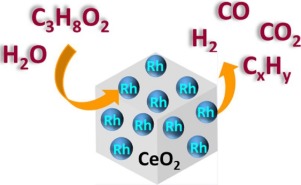Applied Catalysis B: Environment and Energy ( IF 22.1 ) Pub Date : 2017-12-27 , DOI: 10.1016/j.apcatb.2017.12.062 Vetrivel Shanmugam , Ralf Zapf , Volker Hessel , Helmut Pennemann , Gunther Kolb

|
The influence of morphology and crystalline facets of nanoshaped ceria oxide support in Rh/CeO2 and Rh/CeO2/Al2O3 catalysts have been investigated by oxidative steam reforming of propylene glycol in microreactors at 630 °C at S/C = 3.5 and O/C = 0.15. First, well−defined ceria nanorods (NRs) and nanocubes (NCs) have been successfully synthesized by a facile hydrothermal method and then they are deposited on to α−Al2O3. The result of transmission electron microscopy indicates that the ceria nanorods exposed (110) and (100) planes but nanocubes possess only (100) planes. The developed shape controlled ceria nanocrystals and they are mixed with alumina have been used as supports for the preparation of highly dispersed and size controlled Rh nanoparticles of Rh/CeO2 and Rh/CeO2/Al2O3 catalysts. Their performance was tested for the propylene glycol reforming reaction in microreactors, which provide high surface of the catalyst coatings, heat and mass transfer rate and controllability. The XPS and TEM results indicate that the CeO2 morphology shows the selective exposure of different crystal planes which has a significant impact on the dispersion of Rh nanoparticles that influenced in the reforming reaction. The steam reforming reaction experiments show that the ceria nanorods supported Rh catalyst was achieved significantly better activity and stability for 100 h of time on stream than for the all other catalysts. This could be related to the better dispersion of Rh species and the higher surface oxygen vacancies associated with the exposed (100) and (110) crystal planes favor the stabilization of Rh nanoparticles against sintering and elimination of carbon deposition on active Rh nanoparticles during reforming reaction.
中文翻译:

纳米结构的CeO 2负载的Rh对微反应器中丙二醇重整反应的催化活性显着增强
纳米氧化铈载体在Rh / CeO 2和Rh / CeO 2 / Al 2 O 3催化剂中的形态和结晶面的影响已通过在630°C,S / C = 3.5的条件下在微型反应器中进行丙二醇的氧化蒸汽重整研究。并且O / C = 0.15。首先,定义良好的氧化铈纳米棒(NRS)和纳米立方体(NCS)具有由一个浅显的水热法成功地合成,然后将它们沉积在α-Al系2 ö 3。透射电子显微镜的结果表明,二氧化铈纳米棒暴露在(110)和(100)平面上,但是纳米立方体仅具有(100)平面。发达的形状控制的二氧化铈纳米晶体及其与氧化铝的混合已被用作载体,以制备高度分散和尺寸控制的Rh / CeO 2和Rh / CeO 2 / Al 2 O 3催化剂的Rh纳米颗粒。测试了它们在微反应器中进行丙二醇重整反应的性能,该反应器可提供高催化剂涂层表面,传热和传质速率以及可控性。XPS和TEM结果表明CeO 2形态学表明不同晶面的选择性暴露,这对影响重整反应的Rh纳米颗粒的分散性具有显着影响。蒸汽重整反应实验表明,与所有其他催化剂相比,负载二氧化铈纳米棒的Rh催化剂在运行100小时的时间内均具有明显更好的活性和稳定性。这可能与Rh物种更好的分散以及与暴露的(100)和(110)晶面相关的更高的表面氧空位有关,有利于稳定Rh Rh纳米粒子的烧结并消除重整反应过程中活性Rh Rh纳米粒子上的碳沉积。



























 京公网安备 11010802027423号
京公网安备 11010802027423号